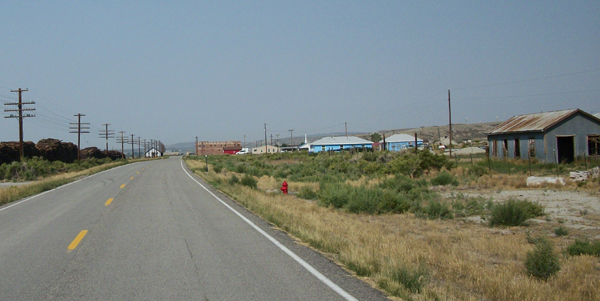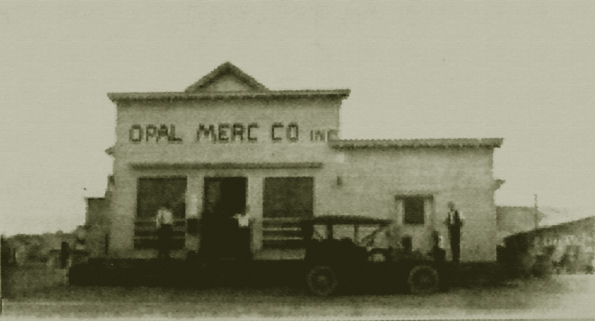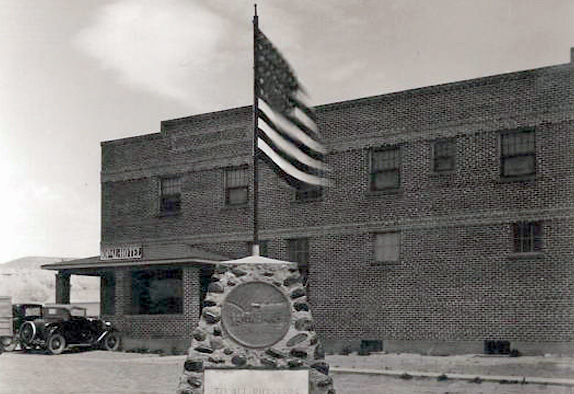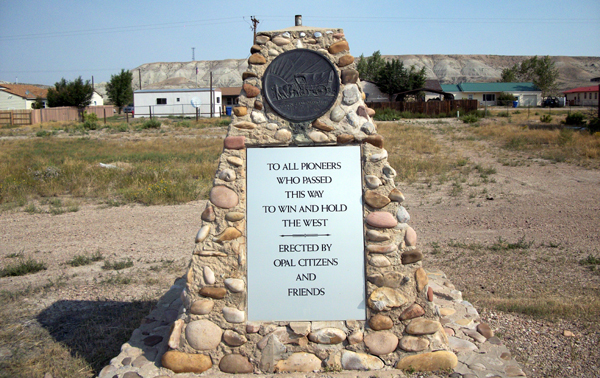
Opal, Wyoming, looking west, 2013, photo by Geoff Dobson.
Twenty-Two miles to the west of Granger on the northerly route, the early traveler came to Opal. The town's name is properly
pronounced with the accent on the second syllable, i. e. "o Pal". There are three versions, all somewhat apocryphal, of the origin of the name: (1.) an official of the
Oregon Short Line Railroad scouting out a location, picked up a stone and was told it was an opal; (2.) the color of the distant mountains appeared to be the
color of an opal; (3.) It took the name of a sheepherder's dog. The sheepherder would call to the dog, named "Pal," "Oh, Pal," also accounting for the
pronounciation. A second version for the promounciation is that a railroad conductor when the train was pulling into the
station would call out "O Pal" with the stress, as conductors often do, on the second syllable.
The Opal Mercantile was established in 1892 and became the largest mercantile establishment in western Wyoming with customers as far north
as Sublette County. It sold everything from tractors, Internation Harvester motor trucks, groceries to gasoline. The central area of
Opal was taken up by the various warehouses for the company. Goods were brought in by as many as ten railroad cars at a time so that
Opal became a major shipping point on the Oregon Short line.

Opal Mercantile Company, 1918, newspaper photo engraving from Kemmerer Camera,
Photographic Edition, April 10, 1918.
.
In 1927, the original building burned. Shortly before the a hotel operated by William H. Solliday
(1852-1926) burned. The
Store was promptly rebuilt with the hotel occupying the top floor.
In 1913, the proprietors of the Mercantile paid for a monument in the town square dedicated to the early
pioneers.

Pioneer Monument, Opal, Monument, aprox. 1928.
In the above photo, the background is the rebuilt Opal Mercantile Building showing the entrance on the left
to the hotel. The inscription on the monument says (see next photo):
TO ALL PIONEERS
WHO PASSED
THIS WAY
TO WIN AND HOLD
THE WEST
__________________
ERECTED BY
OPAL CITIZENS
AND
FRIENDS

Pioneer Monument, 2013, photo by Geoff Dobson.
About 1985,the building was sold and it became the Ham's Fork Supply Company. A portion of the building
was occupied by the Bar-N Bar which installed a long bar along one side along with a stage on which there were
dancers. The stage was backed by
mirrors. In the mid-1980's there was an oil boom in the area. The boom ended in 1987 and thus the building sat
empty as depicted until 2018 when it was acquired by a father and son who
planned to remodel the building as an ammunitions store. See Kemmerer Gazette, April 19, 2018.

Granger, 2013, photo by Geoff Dobson.
Next page: Lyman to Evanston.
|